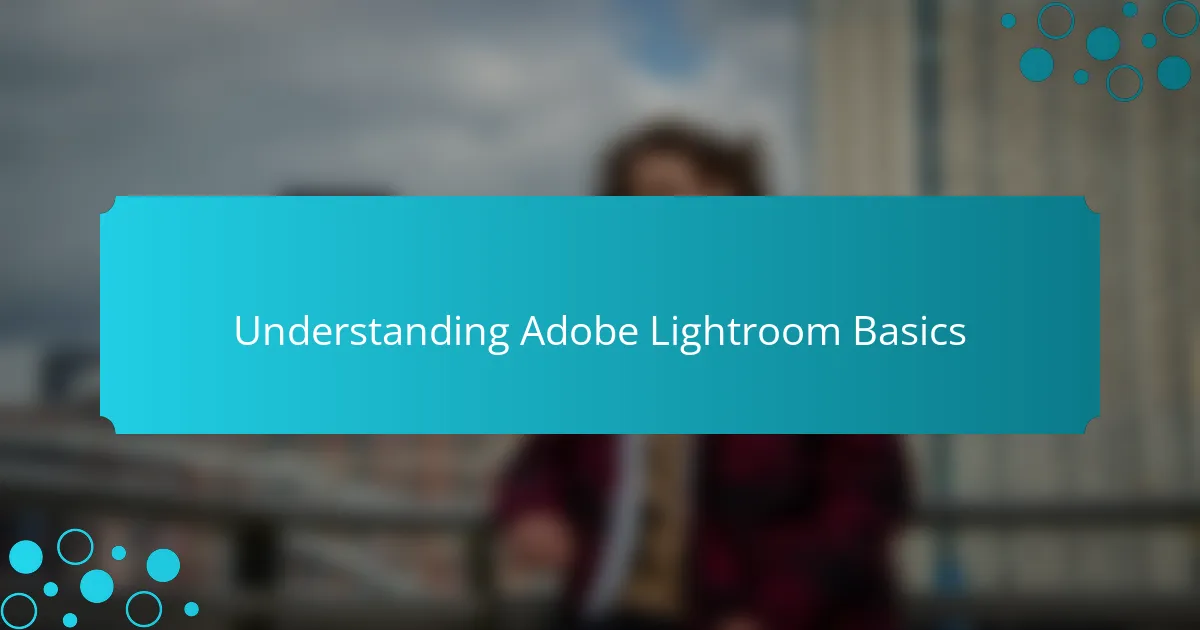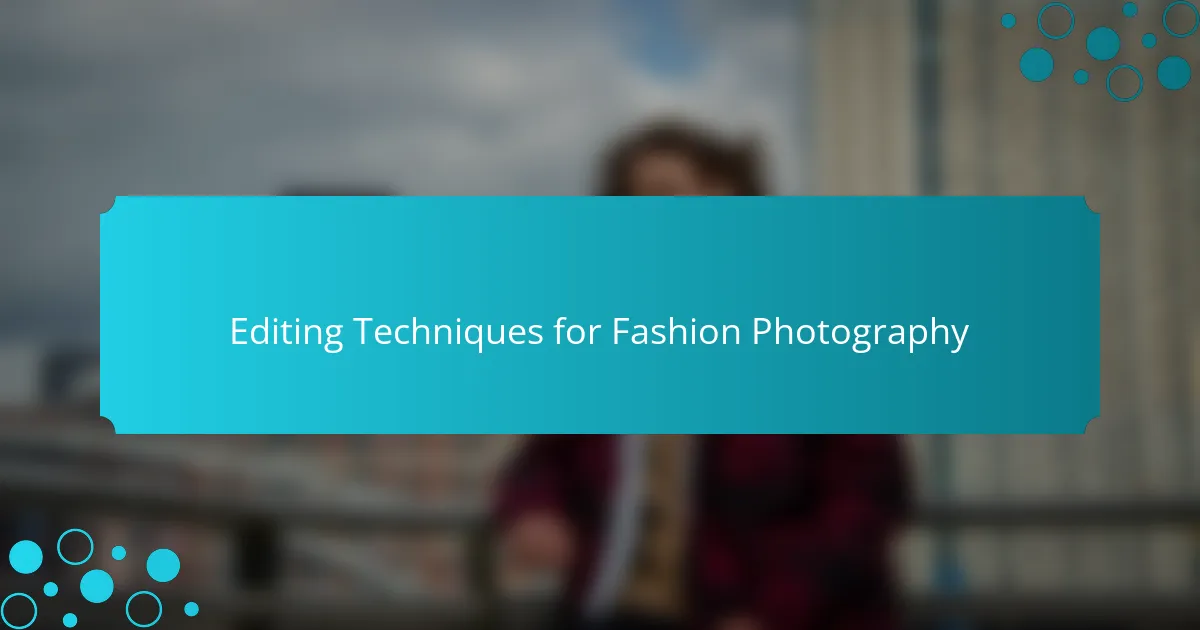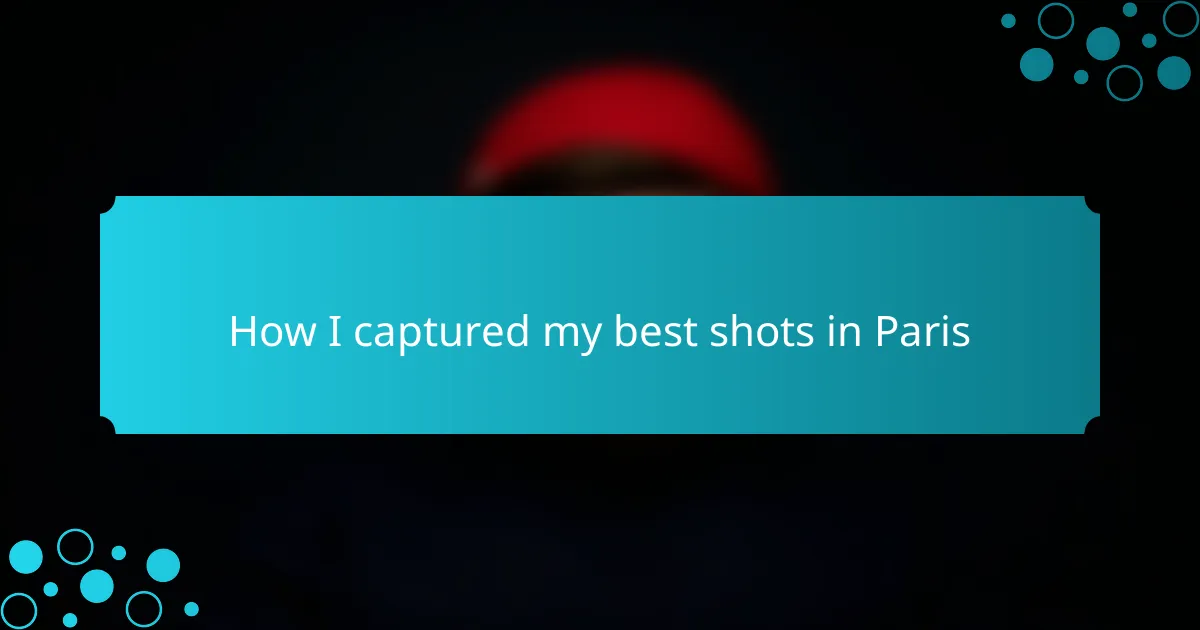Key takeaways
- Adobe Lightroom allows non-destructive editing, enabling photographers to enhance images while preserving the originals.
- Quality photography is vital in fashion, as it captures not only garments but also the unique identity and emotions of models.
- Diversity in modeling portfolios, including various styles and themes, is crucial for appealing to potential clients.
- Effective online showcasing involves authenticity, consistency, and engaging with the audience through social media platforms.

Understanding Adobe Lightroom Basics
Adobe Lightroom is a powerful tool that transforms the way photographers edit and manage their photos. I remember when I first discovered its capabilities; the ability to non-destructively edit images felt like magic. Have you ever wished to enhance your photos without losing the original? That’s the beauty of Lightroom—each adjustment you make can be reversed, allowing for endless creativity.
Understanding the basics of Lightroom starts with its intuitive layout. You have Develop, Library, and other modules that serve different functions. I found that spending a little time organized my workflow significantly. What’s your approach to managing your images? For me, creating collections for specific shoots or themes helped keep everything in order and easily accessible.
It’s also crucial to grasp the concept of presets in Lightroom. When I began, I struggled with creating my style until I experimented with presets. They can save time and maintain consistency in your portfolio. Think about the mood you want to convey—what colors and tones resonate most with your aesthetic? These reflections will guide you in selecting or creating the perfect preset to enhance your photos.

Importance of Photography in Fashion
Photography is the heartbeat of the fashion industry. It captures not only the clothing and accessories but also the emotions and stories behind them. Having experienced firsthand the transformative power of a well-composed photograph, I’ve learned how essential it is for models to connect with their photographers to bring visions to life.
When I started building my portfolio, I realized that the quality of images plays a crucial role in shaping a model’s career. Good photography highlights not only the garments but also the unique persona of each model. I remember my first professional shoot where the photographer focused on lighting and angles; it made all the difference in showcasing my potential as a model.
Professional photographs serve as the first impression in this competitive industry. They help create a strong visual story that resonates with agencies and brands. In my experience, I’ve found that impactful imagery gives a model the platform to shine and stand out in a sea of talent.
| Aspect | Importance |
|---|---|
| Visual Impact | Captures attention and communicates style instantly. |
| Brand Representation | Ensures models resonate with brand identity. |
| Portfolio Development | High-quality shots are essential for a compelling portfolio. |
| Emotional Connection | Creates engaging narratives that attract viewers. |

Strategies for Building a Modeling Portfolio
Building a modeling portfolio is a crucial step in showcasing your unique style and skills. I remember the excitement I felt when I started curating my own portfolio. I focused on selecting images that reflected not only my versatility but also my personality. Each photo session felt like a new adventure, allowing me to express who I am as a model.
In crafting my portfolio, I prioritized diversity. This approach not only highlights my range but also makes my portfolio more appealing to potential clients. I often changed outfits, settings, and even concepts to keep things fresh. I found that connecting with photographers who understood my vision was essential for capturing my best angles.
Here are some strategies I employed:
- Diverse Styles: Include different looks, such as casual, formal, and editorial to showcase versatility.
- Quality over Quantity: Choose your best images rather than including every photo from a shoot.
- Personal Branding: Make sure your portfolio reflects your unique personal style and what you want to convey.
- Professional Collaboration: Work with various photographers and stylists who can help bring your vision to life.
- Regular Updates: Keep your portfolio fresh by updating it with new work regularly.
- Theme-based Shoots: Develop a series of images around a specific theme to tell a visual story.
These strategies helped me build a portfolio that truly represents me, setting the foundation for my modeling career.

Choosing the Right Fashion Shoot Locations
Choosing the right location for a fashion shoot can make all the difference in the world. I remember a shoot where we chose an urban setting with colorful murals. The vibrancy of the backdrop enriched the images, elevating both the garments and my presence in the photos. It’s fascinating how the environment can influence the overall mood—aren’t the right vibes essential for capturing the perfect shot?
In my experience, diversity in locations plays a crucial role in telling a compelling story. One time, I ventured into a serene park for a natural light shoot, which created such a different atmosphere compared to the urban adventure. Each location brings its own unique flavor; exploring options from city streets to peaceful landscapes can expand the creative possibilities for your portfolio.
From my perspective, scouting locations ahead of time is essential. I often find myself visiting potential sites to visualize how the light hits at different times of day. Do you ever imagine how the surroundings can enhance the emotion in your images? I certainly do, and I believe that a well-chosen location not only complements the fashion but also adds layers to the narrative you wish to convey.

Editing Techniques for Fashion Photography
When I first delved into fashion photography, I realized how crucial editing techniques are in truly capturing the essence of a photoshoot. I vividly remember the excitement I felt the first time I adjusted exposure, bringing the model’s features to life against a perfectly balanced backdrop. This moment highlighted the power of subtle tweaks in enhancing the mood and style of an image, making it not just a photo, but a story.
My go-to techniques in Adobe Lightroom have significantly shaped my portfolio over time. Each adjustment I make tells a part of that story, often reflecting the emotions I want to convey in my work. Here are some of the essential techniques I often rely on:
- Color Correction: Perfecting skin tones and background colors to create harmony within the photo.
- Lighting Adjustments: Enhancing or softening shadows and highlights to draw attention to key elements.
- Presets and Filters: Using custom presets that resonate with my aesthetic ensures consistency across my portfolio.
- Clarity and Texture: Fine-tuning these elements adds depth and interest to the image while maintaining a natural look.
- Cropping and Straightening: Framing the shot can make a significant difference in the visual impact, ensuring the focus remains where it should be.

Personal Journey with Adobe Lightroom
Adobe Lightroom has been a game-changer for me in shaping my portfolio. I remember the excitement of my first photoshoot; capturing those perfect moments wasn’t enough until I learned how to enhance them with Lightroom. The transformations I was able to achieve were astounding, breathing new life into images that once felt flat.
As I explored Lightroom’s tools, I discovered the beauty of contrast, color grading, and ease of organization. It felt like each adjustment was telling a story, shaping my creative vision further.
- Exposure Adjustments: Fine-tuning highlights and shadows gave depth to my images.
- Presets: Custom presets saved time and ensured consistency across my portfolio.
- Color Grading: Learning to manipulate colors enabled me to create a unique mood for each shoot.
- Organizational Tags: Tagging my images helped streamline my editing process and made it easier to find specific shots.
- Before-and-After Comparisons: Witnessing the transformation of my raw images was not just satisfying; it built my confidence as a photographer.
Through these features, my passion for fashion and beauty modeling truly flourished, giving me the ability to showcase my work in ways I had previously only imagined.

Tips for Showcasing Your Work Online
When showcasing your work online, authenticity is key. I’ve learned that when your personality shines through your portfolio, it resonates more with viewers. Think about your unique style; how can you express that visually? For me, including behind-the-scenes shots and personal stories from my shoots helped create a deeper connection with my audience.
Another crucial tip is to utilize social media effectively. Platforms like Instagram are powerful tools for displaying your portfolio. I remember the thrill of sharing a well-edited image and receiving positive feedback from followers. It’s all about engaging with your audience—are you responding to comments and messages? Building that two-way communication can foster a loyal following and let potential clients see the human side behind the model.
Don’t forget about the importance of consistency in your online presence. When I first started, I aimed to maintain a cohesive aesthetic across both my portfolio and social media. This could be achieved through a consistent color scheme or style of imagery. What vibe do you want to convey? Aligning your visuals in this way not only showcases your work beautifully but also strengthens your personal brand in the fashion industry.



